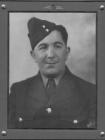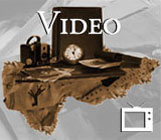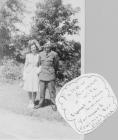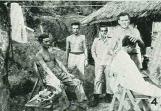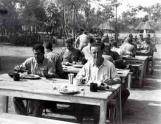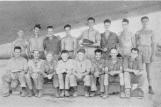1
Albert Talarico shares some of his wartime memories with a grade 11 Social Studies class.14 April 2004
Grand Forks, BC
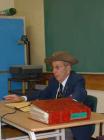
3
Albert TalaricoAt the eastern extremity of the Kettle River Valley and the base of the Monashee Mountains located half way across the southern edge of the province of British Columbia, Christina Lake glistens like a jewel. Perched half way up the mountain side overlooking the eastern shore of the lake, are the remnants of a quarry and a by-gone community that still exists. The tropical rain forests of Burma would be a distinct contrast to Christina Lake, the setting of Albert Talarico's childhood playground.
Fife, the community where Albert Talarico was born on April 27, 1921, had been established as a quarry town. The CM&S company (later Cominco) opened a limestone quarry at this location. The limestone was used as a "flux" agent in the smelting process at the company's lead and zinc smelter in Trail, B.C.. Fife was a "little Italy" as most of the quarry workers and many of the loggers were Italian immigrants. Salvatore (Sam) and Rosalia, Albert's parents, had come to Canada as youngsters from Cosenza, one of the Calabrian provinces of Southern Italy. It was in this environment that Albert and his siblings, "Ace," Gino, Mary and Elvira would happily grow up.
The family remained at Fife until 1929, when Sam decided to relocate his family to nearby Grand Forks. He first owned and operated a garage which he later sold. Then he bought a grocery store and butcher shop which he operated as a family business. Besides going to school, Albert and the other Talarico children helped out in the store.
In 1939, when the war broke out Albert was still in high school, however, he left school after completing grade eleven. His decision to enlist was not a hard one. Although Italy, the home of his ancestors was one of the Axis powers, his loyalty was to his country of birth. In 1942 he did the patriotic thing and signed up. Albert chose the air force because as he stated, "one had to march too much in the army!"
Albert took his basic training in Alberta; first in Calgary and later in Medicine Hat. Upon completion of his training and being certified as an airplane mechanic, he was posted in Yarmouth, Nova Scotia. As a member of the ground crew, his job was to ensure that planes were fit for flight. Early in 1944, Talarico was shipped overseas. Albert along with other Canadian air force personnel were amassing in Bournemouth, England. From there many would see action against Hitler's army in Europe. Many would take part in the largest invasion in the history of mankind, the D-Day Invasion. However, this would not be Albert Talarico's fate. Instead, from England Talarico and some of his mates were flown to the Punjab region of India.
Here, Talarico became part of the 435 Transport Squadron which was formed as a Royal Canadian Air Force unit on November 1st, 1944, at Gujrat, Punjab, India. At the time, the Squadron flew DC3's, Dakota Aircraft, in support of the British Fourteenth Army in Northern Burma (Myanmar). Talarico volunteered to fly in the transports as a "kicker" dropping supplies to the army below. While operating in the Far East, the squadron completed 15,681 missions. During these sorties, the crews moved 27,460 tons of freight, 14,000 passengers and 851 casualties. Four Aircraft were lost and 21 airmen injured. Of the 21, eight were killed, five were wounded, and eight were missing. Fortunately, Albert went through the war physically unscathed, however, he never forgot his fallen comrades particularly the crew of Dakota KN563; comrades in arms who were reported missing in action. Although the plane was never found during the war, it was believed that it went down in a storm in some remote corner of the Burmese jungle.
Talarico remembers that the jungles of Burma were not the forests of the southern interior of British Columbia. Although aircrews always had to be on the alert for enemy air attacks, his empathy was with the foot soldiers of the Fourteenth Army who not only had to face enemy fire, but also had to fight monsoon rains, and malaria- carrying mosquitoes. He recalls with humour Christmas Day dinner, (Burma) 1944. He remembers having chicken for dinner and that the dinner was not very appetizing. He even remembers someone putting ketchup on his chicken to make it more palatable. Certainly it wasn't like the Christmas dinners lovingly prepared by Mamma Talarico. In later years at a squadron reunion Albert inquired of one of his mates as to whom was the individual that had put ketchup on his chicken. His friend replied, "Don't you remember? It was you, Talarico!" To that Albert answered, "If I ate my chicken with ketchup, it must have been really bad!"
At the end of the war, Talarico returned to England and later flew back to Canada. Despite being delayed in Iceland for a week due to a broken wing tip on the plane, Albert Talarico was happy to be on his way home. He knew that he was heading back to his little corner of paradise. Upon his return to civilian life, he was happily reunited with his family in Grand Forks.
Grand Forks, British Columbia, this community, far away from the Burmese jungle, was and would remain Albert Talarico's home town. Here, he would work as a Canada Custom's officer. Here, he met his wife Margaret. Here, he and Margaret would raise their four children, Brian, Rowena, Stephanie, and Jocelyn. And here, in Grand Forks, he and Margaret would spend their retirement years. Despite annual reunions of Squadron 435 veterans and the rekindling of friendships, the war years were slowly becoming a distant memory.
Then came that fateful day in 1995 when a watch found by a Burmese hunter was identified as belonging to a Canadian Flying Officer William Kyle of Perth Ontario, a member of the crew of Dakota KN563. This led to two failed attempts at locating the wreckage of the plane. However, through a coordinated effort between the government of Myanmar, the Canadian Department of Veterans Affairs, Canada Foreign Affairs and the Canadian military a recovery team was established and trained for the recovery. In December 1996 the wreckage was located and the recovery made. According to the Canadian Senates Debates - Issue 83(March 1997):
RCAF Dakota KN 563 went down when the plane was caught in a monsoon cloud with its tremendous wind shear forces; forces that could carry a loaded Dakota straight up at a speed of 6000 feet per minute, and a second later forced it down at the same speed. ...
The crash site was a ravine with a steep slope, and the plane had broken up into hundreds of pieces scattered over an area of about 30 square metres.
The team recovered much wreckage, none of it more than a half metres across, some human remains for burial and the plane's propeller, identification number and roundel from the fuselage,
Because of the efforts of the recovery team, a group of Canadians gathered on March 5 of this year (1997) in Taukkyan War Cemetery, 35 kilometres out of Ragoon to put these six young heroes to rest. This group was led by Lawrence McAulay, Secretary of State for Veterans Affairs, members of the six young men's families, veterans who had served in Burma with the young men,
The service was very moving. It was conducted in full military honour.
From the veterans marching in procession to the grave side, to the careful placing of Canadian soil on the casket, to the bugler sounding the haunting notes of the "Last Post" to the piper playing the "Flowers of the Forest," from the moment posthumous medals and a neatly folded flag were handed to representatives of each family,
(http://www.parl.gc.ca/english/senate/deb-e/83db-e.html)
No longer were the war years a distant memory for Albert Talarico for he was one of the veterans who marched "in procession to the graveside." The faces of his comrades were no longer a blur but as clear as they had been when they served together in this distant land. Never had Talarico been prouder to call himself a Canadian. Never had he been prouder of his government that went through a tremendous effort to locate and recover these warriors. Never had he been so touched as when he was asked to be part of the honour guard for his fallen comrades. Never had there been a truer expressing of the Remembrance Day motto - "Lest We Forget!"
5
Question: Where were you when the war broke out?" Well, I was here in Grand Forks."
Question: What are your thoughts on Canada going to war?
"Well, that's the only thing I could do was go to war. You know, when England declared war on Germany, that sort of thing, and it was the thing we were expected to do."
